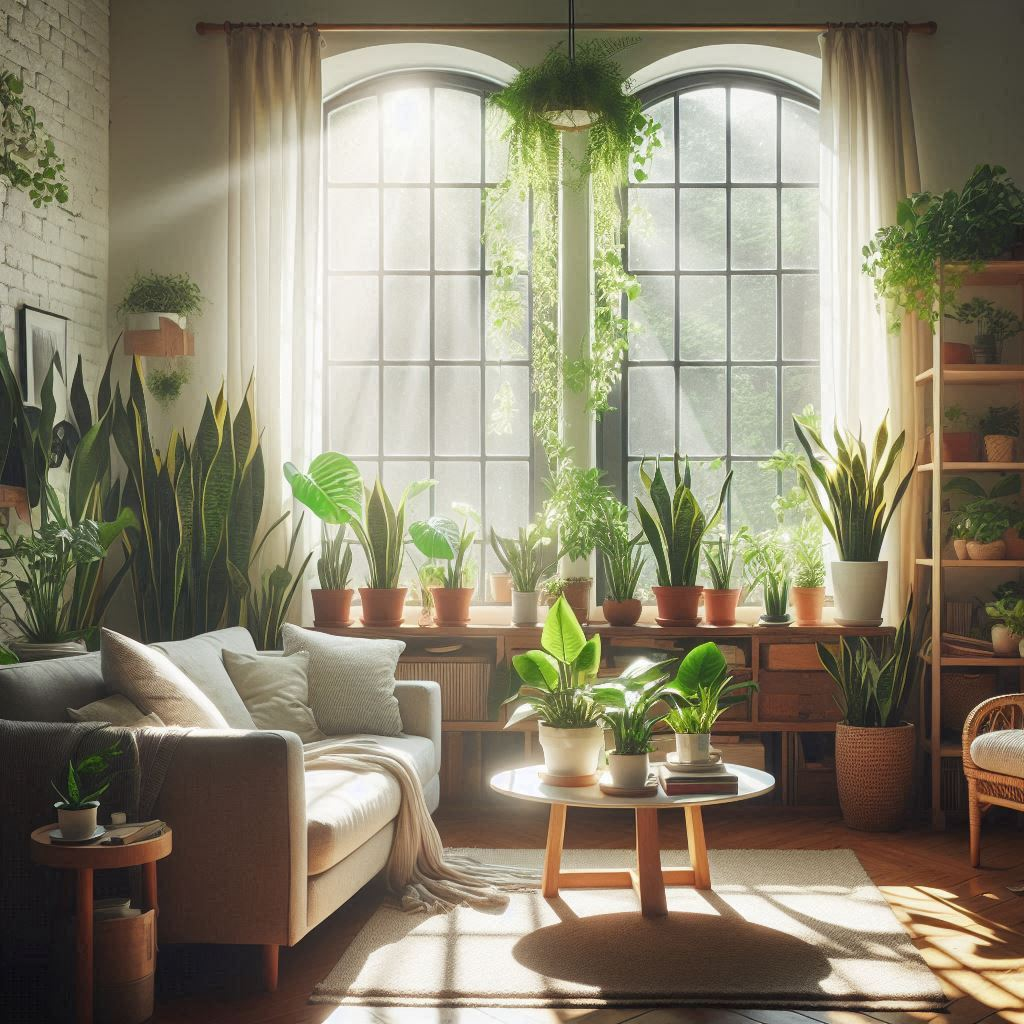
“10 Best Plants for Clean Air at Home”
“10 Best Plants for Clean Air at Home”
“Best plants for clean air: Discover the top 10 air-purifying plants to improve your home’s air quality. Enhance your living space with these natural air purifiers.”


Introduction
Brief Overview of the Importance of Clean Air at Home
Clean air is essential for maintaining a healthy living environment. Poor indoor air quality can lead to various health issues, including allergies, respiratory problems, and fatigue. By improving the air quality in your home, you can create a more comfortable and healthier space for you and your family.
Explanation of How Indoor Plants Can Improve Air Quality
Indoor plants are natural air purifiers. They absorb carbon dioxide and release oxygen through photosynthesis, and some plants can also remove harmful toxins from the air. By incorporating air-purifying plants into your home, you can enhance air quality, reduce pollutants, and create a fresher, more inviting atmosphere.
Plant 1: Spider Plant (Chlorophytum comosum)
Description and Benefits
The spider plant is a popular houseplant known for its long, arching leaves and small white flowers. It is highly effective at removing common indoor pollutants such as formaldehyde, xylene, and toluene. Spider plants are also non-toxic, making them safe for homes with pets and children.
Care Tips and Placement
- Light: Prefers bright, indirect light but can tolerate low light conditions.
- Water: Keep the soil consistently moist but not waterlogged. Allow the top inch of soil to dry out between waterings.
- Placement: Ideal for hanging baskets or placed on shelves where the leaves can cascade.

Plant 2: Snake Plant (Sansevieria trifasciata)
Description and Benefits
The snake plant, also known as mother-in-law’s tongue, has tall, upright leaves with striking green and yellow variegation. It is one of the best plants for improving indoor air quality, as it can remove toxins such as formaldehyde, benzene, and trichloroethylene. Snake plants are also known for their ability to convert CO2 into oxygen at night, making them excellent for bedrooms.
Care Tips and Placement
- Light: Thrives in bright, indirect light but can tolerate low light conditions.
- Water: Water sparingly, allowing the soil to dry out completely between waterings.
- Placement: Suitable for bedrooms, living rooms, and offices.

Plant 3: Peace Lily (Spathiphyllum)
Description and Benefits
The peace lily is a beautiful flowering plant with glossy green leaves and elegant white blooms. It is effective at removing indoor pollutants such as ammonia, benzene, formaldehyde, and trichloroethylene. Peace lilies also help increase humidity levels, which can be beneficial for respiratory health.
Care Tips and Placement
- Light: Prefers low to medium light conditions.
- Water: Keep the soil consistently moist but not waterlogged. Mist the leaves regularly to maintain humidity.
- Placement: Ideal for bathrooms, bedrooms, and shaded corners of the home.
Plant 4: Aloe Vera (Aloe barbadensis miller)
Description and Benefits
Aloe vera is a succulent plant known for its medicinal properties and air-purifying abilities. It can remove pollutants such as formaldehyde and benzene from the air. Aloe vera gel, extracted from the leaves, is also used for its soothing and healing properties on the skin.
Care Tips and Placement
- Light: requires bright, indirect light.
- Water: Water sparingly, allowing the soil to dry out completely between waterings.
- Placement: Suitable for kitchens, living rooms, and sunny windowsills.
Plant 5: Bamboo Palm (Chamaedorea seifrizii)
Description and Benefits
The bamboo palm is a tropical plant with feathery, arching fronds. It is effective at removing indoor air pollutants such as formaldehyde, benzene, and trichloroethylene. Bamboo palms also help increase humidity levels, making them beneficial for dry indoor environments.
Care Tips and Placement
- Light: Prefers bright, indirect light but can tolerate low light conditions.
- Water: Keep the soil consistently moist but not waterlogged. Mist the leaves regularly to maintain humidity.
- Placement: Ideal for living rooms, offices, and areas with indirect sunlight.
Plant 6: English Ivy (Hedera helix)
Description and Benefits
English Ivy is a versatile and hardy plant known for its ability to remove airborne mold and other allergens. It has trailing vines with lush green leaves, making it an attractive addition to any home. English Ivy is particularly effective at reducing levels of formaldehyde, benzene, and xylene.
Care Tips and Placement
- Light: Prefers bright, indirect light but can tolerate low light conditions.
- Water: Keep the soil consistently moist but not waterlogged. Allow the top inch of soil to dry out between waterings.
- Placement: Ideal for hanging baskets or placed on shelves where the vines can cascade.
Plant 7: Boston Fern (Nephrolepis exaltata)
Description and Benefits
The Boston Fern is a popular houseplant known for its feathery, arching fronds. It is highly effective at removing indoor air pollutants such as formaldehyde and xylene. Boston Ferns also help increase humidity levels, which can be beneficial for respiratory health.
Care Tips and Placement
- Light: Prefers bright, indirect light but can tolerate low light conditions.
- Water: Keep the soil consistently moist and mist the leaves regularly to maintain humidity.
- Placement: Ideal for bathrooms, kitchens, and other humid areas of the home.
Plant 8: Golden Pothos (Epipremnum aureum)
Description and Benefits
Golden Pothos, also known as Devil’s Ivy, is a hardy and low-maintenance plant with heart-shaped leaves. It is effective at removing indoor air pollutants such as formaldehyde, benzene, and xylene. Golden pothos is also known for its ability to thrive in a variety of conditions, making it a beneficial choice for beginners.
Care Tips and Placement
- Light: Thrives in bright, indirect light but can tolerate low light conditions.
- Water: Allow the soil to dry out between waterings. Avoid overwatering.
- Placement: Suitable for hanging baskets, shelves, or as a trailing plant on a high surface.
Plant 9: Rubber Plant (Ficus elastica)
Description and Benefits
The rubber plant is a popular houseplant with large, glossy leaves. It is effective at removing indoor air pollutants such as formaldehyde and benzene. Rubber plants are also known for their ability to increase humidity levels, making them beneficial for dry indoor environments.
Care Tips and Placement
- Light: Prefers bright, indirect light but can tolerate low light conditions.
- Water: Keep the soil consistently moist but not waterlogged. Allow the top inch of soil to dry out between waterings.
- Placement: Ideal for living rooms, offices, and areas with indirect sunlight.
Plant 10: Chinese Evergreen (Aglaonema)
Description and Benefits
Chinese Evergreen is a popular houseplant known for its attractive foliage and air-purifying abilities. It is effective at removing indoor air pollutants such as formaldehyde and benzene. Chinese Evergreen is also known for its ability to thrive in low-light conditions, making it a wonderful choice for darker areas of the home.
Care Tips and Placement
- Light: Prefers low to medium light conditions.
- Water: Keep the soil consistently moist but not waterlogged. Allow the top inch of soil to dry out between waterings.
- Placement: Suitable for bedrooms, bathrooms, and shaded corners of the home.
Conclusion
Recap of the Benefits of Having Air-Purifying Plants at Home
Air-purifying plants offer numerous benefits, including improved air quality, reduced pollutants, increased humidity, and enhanced aesthetic appeal. These plants can help create a healthier and more comfortable living environment.
Encouragement to Incorporate These Plants into Your Living Space for Better Air Quality
By incorporating air-purifying plants into your home, you can enjoy the benefits of cleaner air and a more inviting atmosphere. These plants are not only functional but also add beauty and life to your living space. Embrace the power of nature and enhance your home’s air quality with these wonderful plants.
Read also: “10 Effective Kitchen Tips for Busy Families.”
FAQs
- What are the best plants for clean air at home?
- Answer: The best plants for clean air at home include the spider plant, snake plant, peace lily, aloe vera, bamboo palm, English ivy, Boston fern, golden pothos, rubber plant, and Chinese evergreen.
- How do indoor plants improve air quality?
- Answer: Indoor plants improve air quality by absorbing pollutants, releasing oxygen, and increasing humidity levels, which helps to reduce airborne toxins and allergens.
- What are the benefits of having air-purifying plants at home?
- Answer: Air-purifying plants can enhance indoor air quality, reduce stress, improve mood, and create a healthier living environment.
- How do I care for air-purifying plants?
- Answer: Care for air-purifying plants by providing the right amount of light, water, and humidity. Each plant has specific care requirements, so it’s important to follow guidelines for each type.
- Can air-purifying plants help with allergies?
- Answer: Yes, air-purifying plants can help reduce allergens by trapping dust and other particles, improving overall air quality, and potentially alleviating allergy symptoms.
- Which air-purifying plants are safe for pets?
- Answer: Some air-purifying plants that are safe for pets include the spider plant, bamboo palm, and Boston fern. Always check for pet safety before introducing new plants to your home.
- How many air-purifying plants do I need for my home?
- Answer: The number of air-purifying plants needed depends on the size of your home and the level of air quality improvement desired. Generally, having a few plants in each room can make a noticeable difference.
- Can air-purifying plants survive in low-light conditions?
- Answer: Some air-purifying plants, such as the snake plant and golden pothos, can thrive in low-light conditions. It’s important to choose plants that match the lighting conditions of your home.
- What are the easiest air-purifying plants to care for?
- Answer: Some of the easiest air-purifying plants to care for include the snake plant, spider plant, and aloe vera. These plants are low-maintenance and resilient.
- Do air-purifying plants require special soil?
- Answer: While most air-purifying plants don’t require special soil, we recommend using a well-draining potting mix. Some plants may benefit from specific soil types, so it’s best to follow care instructions for each plant.





One Comment
Pingback: